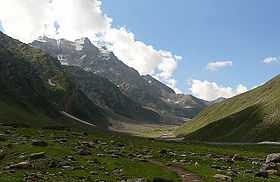Lake Saiful Muluk
| Saiful Muluk | |
|---|---|
.jpg) Saiful Muluk in winter | |
| Location | Kaghan Valley |
| Coordinates | 34°52′37″N 73°41′40″E / 34.876957°N 73.694485°ECoordinates: 34°52′37″N 73°41′40″E / 34.876957°N 73.694485°E |
| Lake type | Alpine/Glacial lake |
| Primary inflows | Glaciers water |
| Basin countries | Pakistan |
| Surface area | 2.75 km2 (1.06 sq mi) |
| Surface elevation | 3,224 metres (10,577 ft) |
| Settlements | Naran |

Saiful Muluk (Urdu: جھیل سیف الملوک) is a mountainous lake located at the northern end of the Kaghan Valley (34°52′37.34″N 73°41′37.71″E / 34.8770389°N 73.6938083°E), near the town of Naran.[1] It is in the north east of Mansehra District in the Khyber-Pakhtunkhwa province, Pakistan. At an altitude of 3,224 m (10,578 feet) above sea level, it is well above the tree line, and is one of the highest altitude lakes in Pakistan.
Location
Saiful Muluk is located in the Mansehra district of Khyber Pakhtunkhwa, about eight kilometers north of Naran,[2] in the Northern part of Kaghan valley. Malika Parbat, the highest peak in the valley is near the lake.[3]
The lake is accessible from the nearby town of Naran throughout the summer season.

Physical features
Saiful Muluk was formed by glacial moraines that blocked the water of the stream passing through the valley.[4] The Kaghan Valley was formed in the greater Pleistocene Period dating back almost 300,000 years when the area was covered with ice. Rising temperatures and receding glaciers left a large depression where glaciers once stood. Melting water collected into the lake.
Ecology
The lake has rich eco diversity and holds many species of blue-green algae. Large brown trout are found in the lake, up to about seven kilograms.[5] About 26 species of vascular plant exist in the area, with Asteraceae the most commonly found specie. Other species commonly found in the region are: Ranunculaceae, Compositae, Ranunculaceae, Cruciferae, Gramineae, Apiaceae, Leguminosae, Scrophulariaceae and Polygonaceae.[1]
The Lake in Poetry
A fairy tale called Saiful Muluk, written by the Sufi poet Mian Muhammad Bakhsh, talks of the lake.[6][7] It tells the story of the prince of Persia who fell in love with a fairy princess at the lake.[8] A poet and writer from Balakot, Ahmed Hussain Mujahid, wrote the story of Saiful Muluk in prose depicting the local version.
See also
- Lulusar lake
- Ansoo Lake
- Dudipatsar lake
- Mahodand lake
References
- ↑ 1.0 1.1 Zia-ur-Rehman Mashwani; Muhammad Arshad, Mushtaq Ahmad, Mir Ajab Khan (June 2011). "Diversity and distribution pattern of alpine vegetation along Lake Saif-ul-Mulook, Western Himalaya, Pakistan" (PDF). International Proceedings of Chemical, Biological and Environmental Engineering (Singapore: International Association of Computer Science and Information Technology Press) 16: 155–162. doi:10.7763/IPCBEE. ISSN 2010-4618. Retrieved 20 September 2012.
- ↑ Ihsan Ali. "Natural Heritage of Kaghan Valley". Mapping and Documentation of the Cultural Assets of Kaghan Valley, Mansehra (PDF) (Report). Islamabad: UNESCO. p. 46. Retrieved 20 September 2012.
- ↑ Manzoor Hussain; Ghulam Mujtaba Shah, Mir Ajab Khan (5 March 2006). "Traditional Medicinal and Economic uses of Gymnosperms of Kaghan Valley, Pakistan". Ethnobotanical Leaflets 10: 72. ISSN 1948-3570. Retrieved 20 September 2012.
- ↑ J. Ehlers; P.L. Gibbard (29 July 2004). Quaternary Glaciations - Extent and Chronology (2 ed.). Elsevier. pp. 305–306. ISBN 978-0444515933. Retrieved 16 September 2012.
- ↑ Muhammad Yaqoob (14 March 2003). "Production and culture of trout in the Northwest Frontier Province and Northern Areas of Pakistan, A review". In T. Peter, S. B. Swar. Cold water fisheries in the trans-Himalayan countries. Rome: Food and Agriculture Organization. p. 327. ISBN 978-9251048078. Retrieved 16 September 2012.
- ↑ http://windsweptwords.com/2013/04/27/the-legend-of-saif-ul-malook-part-iv/
- ↑ Saif-ul-Malook in miniature art
- ↑ Pristine lakes of the north
External links
| Wikimedia Commons has media related to Lakes of Pakistan. |